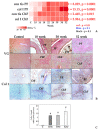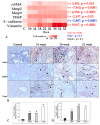Jagged-1/Notch Pathway and Key Transient Markers Involved in Biliary Fibrosis during Opisthorchis felineus Infection
- PMID: 36355906
- PMCID: PMC9697314
- DOI: 10.3390/tropicalmed7110364
Jagged-1/Notch Pathway and Key Transient Markers Involved in Biliary Fibrosis during Opisthorchis felineus Infection
Abstract
Chronic opisthorchiasis associated with Opisthorchis felineus infection is accompanied by severe fibrotic complications. It is of high practical significance to elucidate the mechanisms of hepatic fibrosis in chronic infection dynamics. The goal of the study is to investigate the temporal profile of key markers and the Jagged1/Notch signaling pathway in the implementation of fibrosis in a chronic O. felineus infection. For the first time, using histological methods and real-time PCR analysis, we demonstrated the activation of the Jagged1/Notch pathway in liver fibrogenesis, including the activation of the Hes1 and Hey1 target genes during experimental opisthorchiasis in Mesocricetus auratus. Cluster analysis followed by regression analysis of key markers during the infection showed that Jagged1 and Mmp9have the greatest contribution to the development of cholangiofibrosis and periductal fibrosis. Moreover, we detected a significant increase in the number of Jagged1-positive cells in the liver of chronic opisthorchiasis patients compared to that of the control group without infection. The results of the study are extremely informative both in terms of investigation both diverse fibrosis mechanisms as well as potential targets in complex antihelmintic therapy.
Keywords: Jagged1/Notch pathway; Opisthorchis felineus; Syrian hamster; extracellular matrix; human; liver fibrosis.
Conflict of interest statement
The authors declare no conflict of interest.
Figures








Similar articles
-
Characteristics of liver fibrosis associated with chronic Opisthorchis felineus infection in Syrian hamsters and humans.Exp Mol Pathol. 2019 Oct;110:104274. doi: 10.1016/j.yexmp.2019.104274. Epub 2019 Jun 19. Exp Mol Pathol. 2019. PMID: 31226265
-
Hepatic vascular changes associated with Opisthorchis felineus infection in Syrian hamsters and humans.Acta Trop. 2024 Feb;250:107100. doi: 10.1016/j.actatropica.2023.107100. Epub 2023 Dec 14. Acta Trop. 2024. PMID: 38101765
-
Opisthorchis felineus infection provokes time-dependent accumulation of oxidative hepatobiliary lesions in the injured hamster liver.PLoS One. 2019 May 14;14(5):e0216757. doi: 10.1371/journal.pone.0216757. eCollection 2019. PLoS One. 2019. PMID: 31086416 Free PMC article.
-
Opisthorchis felineus infection and cholangiocarcinoma in the Russian Federation: A review of medical statistics.Parasitol Int. 2017 Aug;66(4):365-371. doi: 10.1016/j.parint.2016.07.010. Epub 2016 Jul 26. Parasitol Int. 2017. PMID: 27474689 Review.
-
Opisthorchiasis and the Microbiome.Adv Parasitol. 2018;102:1-23. doi: 10.1016/bs.apar.2018.07.001. Epub 2018 Aug 17. Adv Parasitol. 2018. PMID: 30442306 Review.
Cited by
-
Ad6-Based GM-CSF Expressing Vector Displays Oncolytic and Immunostimulatory Effects in an Immunocompetent Syrian Hamster Model of Cholangiocarcinoma.Viruses. 2025 Jan 24;17(2):162. doi: 10.3390/v17020162. Viruses. 2025. PMID: 40006917 Free PMC article.
-
Mechanical homeostasis imbalance in hepatic stellate cells activation and hepatic fibrosis.Front Mol Biosci. 2023 Apr 20;10:1183808. doi: 10.3389/fmolb.2023.1183808. eCollection 2023. Front Mol Biosci. 2023. PMID: 37152902 Free PMC article. Review.
-
Roles of X-box binding protein 1 in liver pathogenesis.Clin Mol Hepatol. 2025 Jan;31(1):1-31. doi: 10.3350/cmh.2024.0441. Epub 2024 Oct 2. Clin Mol Hepatol. 2025. PMID: 39355873 Free PMC article. Review.
-
Liver Fluke-Derived Molecules Accelerate Skin Repair Processes in a Mouse Model of Type 2 Diabetes Mellitus.Int J Mol Sci. 2024 Nov 8;25(22):12002. doi: 10.3390/ijms252212002. Int J Mol Sci. 2024. PMID: 39596069 Free PMC article.
References
-
- Mairiang E., Laha T., Bethony J.M., Thinkhamrop B., Kaewkes S., Sithithaworn P., Tesana S., Loukas A., Brindley P.J., Sripa B. Ultrasonography assessment of hepatobiliary abnormalities in 3359 subjects with Opisthorchis viverrini infection in endemic areas of Thailand. Parasitol. Int. 2012;61:208–211. doi: 10.1016/j.parint.2011.07.009. - DOI - PMC - PubMed
-
- Maksimova G.A., Pakharukova M.Y., Kashina E.V., Zhukova N.A., Kovner A.V., Lvova M.N., Katokhin A.V., Tolstikova T.G., Sripa B., Mordvinov V.A. Effect of Opisthorchis felineus infection and dimethylnitrosamine administration on the induction of cholangiocarcinoma in Syrian hamsters. Parasitol. Int. 2017;66:458–463. doi: 10.1016/j.parint.2015.10.002. - DOI - PMC - PubMed
Grants and funding
LinkOut - more resources
Full Text Sources

